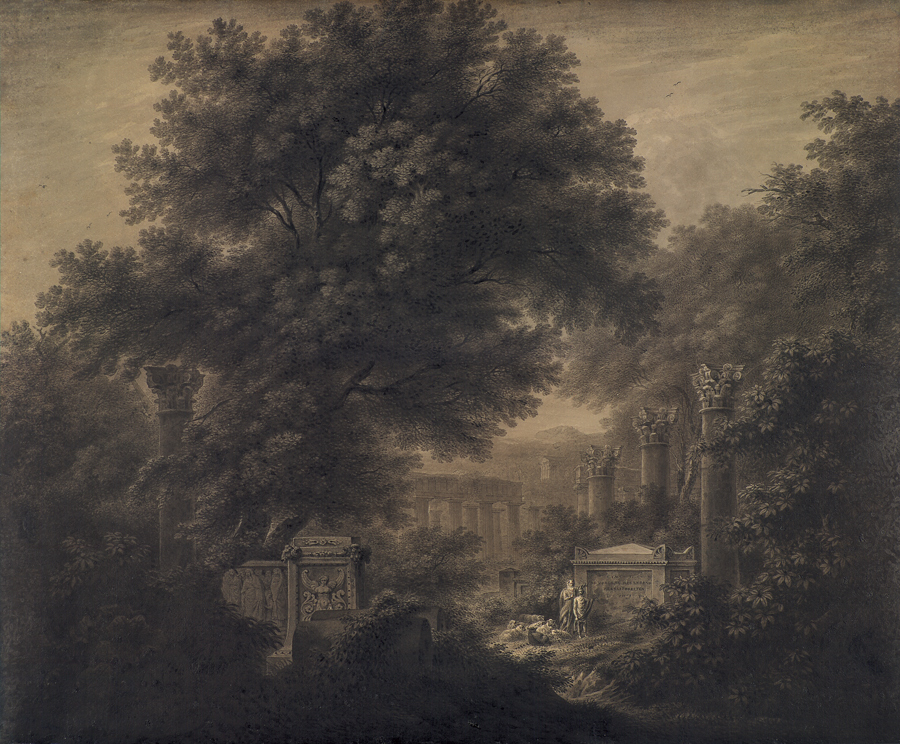Loading the page ...
Simon Petrus Klotz
(1776 Mannheim – 1824 Munich)
Arcadian Landscape with Ancient Ruins and Shepherds. Pen and black ink, over pencil, black and gray wash. 44.4 x 54.5 cm. Ca. 1800.
The working life of the painter and lithographer Simon Petrus Klotz covers the decades before and after 1800 in an epoch of radical artistic transformation. Klotz came from a family of artists. His father Matthias had been Landscape Painter to the Hoftheater in Munich since 1778. It was from him that he received his initial training, after which Klotz went to study under the renowned Munich court painter, Johann Jakob Dorner the Elder. Bright watercolour landscapes were characteristic of Klotz’ early work, large parts of which must regrettably be considered lost. Several journeys undertaken in the years 1798–1800 took him to Vienna, Berlin, and Dresden, the birthplaces of the German Romantic movement, which was to have a profound influence on his later artistic work. In spring 1804, Klotz was appointed Professor for the Theory of Fine Arts at the University of Landshut. Like many of his fellow German artists he was drawn to Rome, which he visited shortly after taking up his new post in the years 1804–1805. He captured the Roman Campagna in oil paintings and lithographs. After his return he received great acclaim for his Italian works, only a few of which have survived.
The present drawing by Klotz, which portrays a southern fantasy landscape, testifies both to his study of ancient monuments in Italy and to the popularity of the Arcadia theme in the late 18th century. In this capriccio, composed like a theatrical set, Klotz depicts the ideal beauty of ancient ruins and the former greatness of classical antiquity. The work also betrays the influence of his father, who had mainly specialized in designing sets for Italian operas. But the delicate and lucid contours and lines, with which Klotz renders Doric, Ionic and Composite columns, temples, sarcophagi and sculptural fragments, reveal the Classicist training he received from Dorner.
At the same time Klotz incorporates into the drawing the memento mori theme, which is symbolized by the unbridled power of nature. In the foreground a mighty oak, whose leaves are rendered with meticulous accuracy, has overgrown the ancient ruins. Leaves and undergrowth have largely covered the toppled and broken columns and reliefs, while ivy hangs down from the entablature of the temple sketched in the background. The theme of transience reaches its visual culmination in the right foreground, where a shepherd and his son, both clad in antique-style garments and picked out by bright patches of light, are standing before a monumental sarcophagus and pointing at a warning inscription. The famous phrase Et in Arcadia ego ("I too was in Arcadia") instantly springs to mind. This ancient saying, which goes back to Virgil’s Eclogues and had been a topos in European painting since the original versions of Il Guercino and Poussin, inspired numerous artists in the 18th century as well. However, the pessimistic and contemplative notion that omnipresent death does not spare people even in Arcadia gradually underwent a fundamental change of meaning. In the works of Goethe the Arcadian myth reached its apogee of perfection, after which it became a triumphal celebration of life, symbolizing the perfect synthesis of mastery and nature, dream and reality, and the modern and ancient worlds (see Reinhardt Brandt, Arkadien in Kunst, Philosophie und Dichtung, Freiburg-Berlin 2005). Some thirty years later Klotz produced a variation on the theme by giving it a different inscription which reads: So vergehen des Lebens Herrlichkeiten (German for Sic transit gloria mundi, tr.). Instead of the ancient epigram the artist selected a motto with a religious, Christian tenor, thus showing his profound debt to the ideas of the Romantic movement. The ruins symbolize the decline and fall of once great civilizations. His rendering of the ancient formal canon is thus highly ambivalent in character. In comparison to the sunny, idyllic Arcadia of Goethe’s time, nature is shown by Klotz in dark, oppressive tones which evoke an underlying mood of melancholy. It reflects the inner conflicts of the artist, who had to resign his professorship in 1807 because of mental illness. A truly Romantic fate!
Contact us for further information